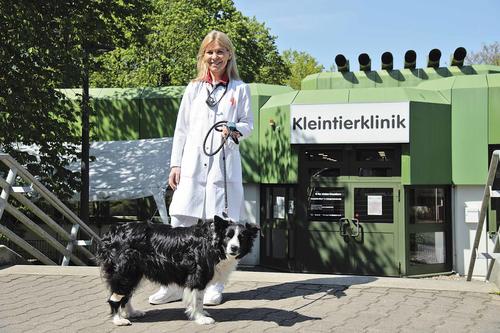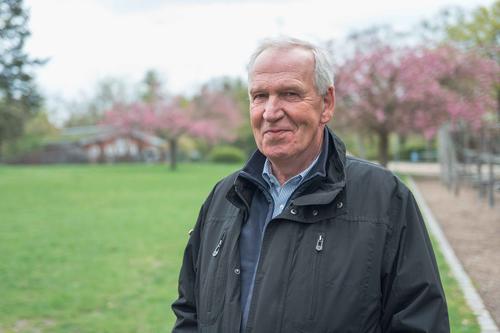Of dog, cat, and horse
The history of veterinary medicine in Berlin dates back to 1787; meanwhile, veterinary medicine at Freie Universität is an excellent location for veterinary research and education.
May 26, 2023
At the Düppel site, horses are operated on, hamsters and dogs are examined - and sea eagles can also be helped.
Image Credit: Bernd Wannenmacher
The dog has acute respiratory distress, the cat no longer eats, the guinea pig's eyes are watering: if you have a serious problem with your beloved pet in Berlin, the Small Animal and Pet Clinic of Freie Universität is one of the first addresses. The clinic in the Düppel district of Berlin includes an internal medicine and surgery department, a cardiology department, and also an eye specialist.
90 percent of the patients in Düppel are dogs and cats. Pet animals such as rabbits, guinea pigs and ferrets are also treated here, as well as pet birds and reptiles. The head of the small animal clinic, Prof. Dr. Barbara Kohn, is convinced that pets have a beneficial effect on the psyche of their owners and can be important helpers in crisis situations. "Many studies have proven this," she says. Especially elderly and single people, pets would give support and stability.
The head of the small animal clinic, Prof. Dr. Barbara Kohn: "Pets give support and stability especially to elderly and single people."
Image Credit: Bernd Wannenmacher
But wild animals also receive medical care in Düppel. The Berlin Senate provides money for this. "We take care of all wild animals that are brought to us," Kohn emphasizes. Most of the time, it's birds. "Right now, a white-tailed eagle is receiving treatment." He probably has lead poisoning, presumably from lead-containing ammunition, he says.
The Small Animal and Pet Clinic is one of three veterinary clinics at Freie Universität and an important part of the university's veterinary medicine program. In addition to treating sick animals, the tasks of the Düppel veterinarians include training students and conducting research. "Infectious diseases are a focus of our research work," Kohn explains. "For example, we conduct intensive research on babesiosis, a tick-borne parasitic disease in dogs that leads to destruction of red blood cells and subsequent anemia." If left untreated, this disease can be fatal. Immune diseases, hormonal disorders, gastrointestinal disorders and skin diseases are also researched and focused on at the Small Animal Hospital.
Dr. Christian Laiblin, specialist veterinarian and administrative head of the Department of Veterinary Medicine from 2002 to 2014, knows how difficult it was to merge veterinary medicine in East and West Berlin after the fall of the Wall.
Image Credit: Bernd Wannenmacher
Two centuries of Berlin veterinary medicine
Veterinary education in Berlin has a long history. At the instigation of Frederick the Great, the Royal Veterinary School was founded here in 1787 by his nephew Frederick William II. Better horse doctors for the army's large horse needs as well as veterinarians to prevent animal epidemics were to be trained there. In 1887 the institution was renamed the Veterinary College, and in 1910 the right to confer doctorates was introduced. In 1934 it was incorporated into the Friedrich-Wilhelms University, and in 1937 an independent veterinary faculty was formed.
After the war - the Friedrich-Wilhelms-Universität became the Humboldt-Universität - veterinary medicine initially remained in the eastern part of Berlin. As the pressure and influence of the political system grew there, around 200 students, seven professors and 30 assistants moved to the western part of the city in 1950 and founded the "Notgemeinschaft der Veterinärmediziner" (Emergency Community of Veterinary Physicians), which was incorporated into the Free University, which had now existed for three years, in 1951 by resolution of the House of Representatives. Until the fall of the Berlin Wall, Berlin now had two veterinary faculties.
Prof. Dr. Leo Brunnberg, former dean of the Department of Veterinary Medicine: "Appointments were a focus of my work."
Image Credit: Bernd Wannenmacher
When the Berlin Senate and House of Representatives decided in 1992 to merge the two faculties under the umbrella of Freie Universität, initially for a period of five years, this led to problems. Members of both faculties were initially reluctant to cooperate, partly for political, partly for professional, but also for personal reasons. In addition, the Science Council recommended limiting the training capacity to 200 new students per year, which meant that almost 40 percent of all existing positions were cut. Dr. Christian Laiblin, a specialist veterinarian and administrative head of the Department of Veterinary Medicine from 2002 to 2014, remembers well how difficult it was to overcome prejudices on both sides. "In addition, the two faculties had very different orientations," Laiblin says. In the western part of Berlin, the focus was on treating domestic animals; in the eastern part, on farm animals. The two now had to be merged - without layoffs. "The original positions at Humboldt University were gradually reduced or transferred to the Freie Universität's staffing plan, in part because colleagues also had to move to other disciplines, which was not infrequently met with resistance," Laiblin explains. However, almost all of them were able to adjust quickly. No sooner had this tour de force been mastered than a special cut was imposed on the subject area. The House of Representatives decided to cut the educational capacity by another quarter - combined with a corresponding reduction in funding and the number of positions. Calling the merger of the two faculties a challenge is euphemistic, even in retrospect.
In 2003, shortly after Laiblin took office, Prof. Dr. Leo Brunnberg became dean of the Department of Veterinary Medicine. Both assertive and goal-oriented, they first had to work together. "In the beginning, there was a lot of bickering," Laiblin recalls, laughing. "But then we quickly realized that we complemented each other ideally." Brunnberg sees it that way, too. "Our collaboration has brought veterinary medicine a long way forward," he says looking back. For ten years, Brunnberg and Laiblin led the department and completed the merger. "Appeals were a major focus of my work," Brunnberg says. He put a lot of effort into getting the best in their field to Berlin, he says. That has also had an impact on teaching, he says. More than 90 percent of the students finished their studies within the standard period of study, he says.
In addition to all the administrative work, Brunnberg continued to operate and teach in the small animal clinic, and Kohn does the same today. "First and foremost, I'm a veterinarian," she says. "I often do the administrative work after hours or on weekends."
Prof. Dr. Christoph Lischer, Professor of Equine Surgery: "When a horse breaks its leg, it doesn't necessarily mean that its life is over.
Image Credit: Bernd Wannenmacher
Equine medicine with passion
Dr. Christoph Lischer is also fully committed to his work. He is Professor of Equine Surgery and has been Head of the Clinic for Equine, General Surgery and Radiology since October 2009. Together with enthusiastic young veterinarians, he has made the clinic what it is today - an excellent training facility, a clinic where people from Germany and abroad bring their horses.
"We specialize in treating fractures and osteoarthritis in horses, and also in performing abdominal surgery when severe colic necessitates it," Lischer explains. Horses are tricky, though, he adds. "It takes a lot of finesse to anesthetize a horse so that it wakes up in good condition afterwards." Compared to all other animals, horses are also particularly sensitive to wound infections, he adds.
Care after surgery is also difficult, he said. "Horses can be unpredictable," Lischer says. It can therefore be dangerous for the nursing staff when it comes to changing dressings or giving injections. At the equine clinic, however, they have that in the Griff, he says. "Our team is well trained and very experienced," Lischer emphasizes. That's important, he says, because there are now many more treatment options than in the past. "Today, if a horse breaks its leg, that doesn't mean its life has to be over." Old Fritz's horse doctors would certainly have seen things differently 200 years ago.
By Regina Köhler





